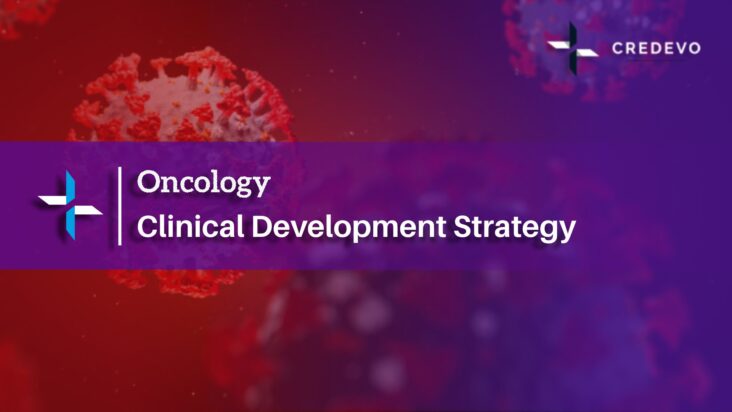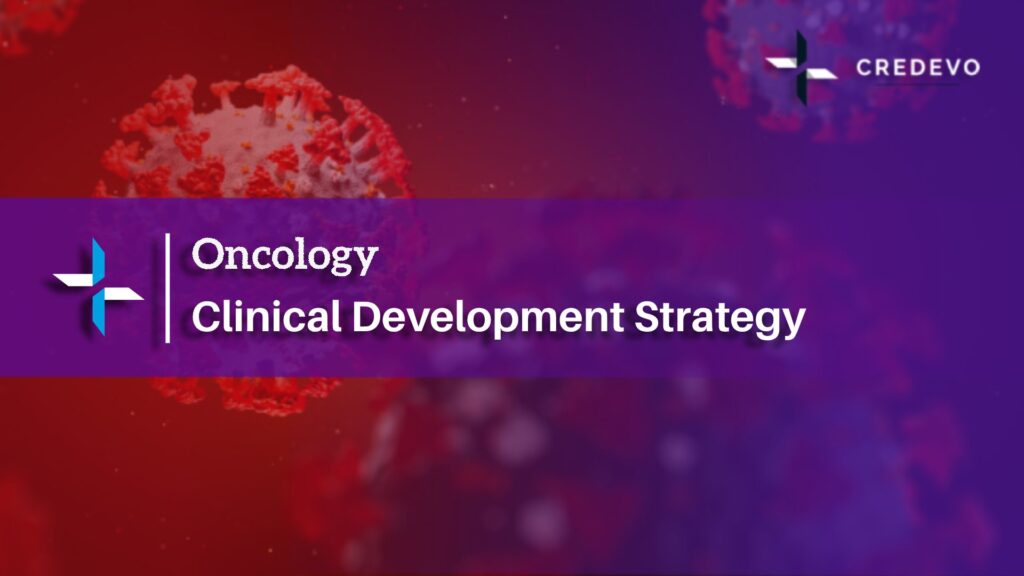Clinical Development Strategy In Oncology

Oncology trials are more complex than trials in any other therapeutic area. Research in oncology differs in terms of trial design, trial types, the role of a comparator, treatment outcomes, adverse event reporting, interpreting the results, and more. Developing a well-defined clinical development strategy for oncology clinical trials is crucial due to the significant costs, time commitment, and challenges associated with this field of research.

The growth in the global oncology market is moving at a rapid pace. In 2017, the oncology drug market was valued at $97,400 million and was estimated to reach $ 176,509 million by 2025, registering a CAGR of 7.6%. Similarly, there is an increase in research and clinical trials.
Despite this rapid growth, there are several hiccups. For example, a study reports that only 5.1% of new cancer drugs tested in Phase I are likely to receive FDA approval. The success rate of clinical trials moving from Phase I to Phase II is 63%, and 25% from reaching Phase II to Phase III.
Before discussing the challenges and the strategies required to overcome them, let’s examine the global statistics of clinical trials.
Clinical trial statistics in Oncology
Currently, 77,626 trials are registered in oncology on clinicaltrials.gov globally, with 22,352 ongoing clinical trials.
The USA registers the highest number of trials (11,424), followed by Europe (6,640) and China (3,355).
Improvements in oncology research
Along with the increasing statistics, there are markable improvements in the oncology research industry.
- The 15 therapeutic drugs were approved and launched in 2019.
- More than half of the approved treatments were from the oral route.
- Most of the treatments bought were applicable for varying cancer populations and in earlier lines of therapies.
- The research in immuno-oncology trials has increased.
- In the past five years, 57 newly discovered drugs received approval for 89 indications.
- In 2019, 11 oncology drugs received FDA approvals.
- Seven of these approvals were for the drugs used to treat solid tumors, and four were for the drugs used to treat hematologic malignancies.
Besides these improvements, the clinical trials in oncology present a few challenges to overcome. Here are the top challenges in oncology.
Top 10 challenges in oncology clinical trials
Every clinical trial has its unique challenges, but here is the list of challenges that most clinical trials experience.
- Lack of well-defined strategies
- Poor selection of ideal study designs
- The complexity of trial design
- Regulatory hurdles
- Identifying perfect sites and investigators
- Patient recruitment and retention
- Lack of predefined study end-points
- Significant costs involved in oncology clinical trials
- Data collection and analysis
- Collaboration and multidisciplinary coordination
Clinical development strategy in oncology trials
Developing a perfect clinical development strategy for clinical trials in oncology is crucial as the research involves significant costs, time, and challenges. So creating a well-defined path reduces the hurdles, and avoids delays and costs that incur due to delays.
A clinical development strategy is a clear, structured path designed from the late pre-clinical stage to phase III studies. An ideal strategy defines every step in clinical development and foresees the hurdles that may arise through applying scientific knowledge.
Let’s see the challenges in oncology trials and the clinical development strategy to manage those challenges briefly.
Country selection
Before even planning a clinical trial, it’s obvious to find the country you need to conduct your clinical trials. The country you choose impacts your clinical trials in many ways, such as
- Regulatory scenario and approval timelines.
- The patient population is available for recruitment and clinical trial awareness.
- Cost per site or cost per study in that particular region.
- Data acceptance with other regulators.
- The number of sites and site reachability.
- Logistics and supply chains.
- Language barriers and other considerations.
Along with these factors, there are many more while choosing a region.
When unsure about the region, it’s wise to conduct country-level clinical trial feasibility to answer all these questions, which may help move optimistically forward by foreseeing the hurdles that may arise during the trial conduction.
To learn more about country-level feasibility, please click here.
Regulatory
Considering the regulations is another aspect of clinical development strategy.
- Some of the regulators offer special considerations in the designs. For example, the FDA recommends using adaptive designs such as Basket trial designs, Platform trial designs, and Umbrella trial designs.
- FDA, EMA, PMDA, etc offer fast-track approvals and priority approval for a selected class of drug research, which fastens the development process.
- Regulators provide special incentives and benefits for Oncology-rare diseases.
- Few regulators accept overseas clinical trial data. It is obvious to conduct the clinical trial in a country like the USA, where the clinical trial data from the USA is widely acceptable. For example, PMDA, in some circumstances accepts clinical data from the USA.
Clinical trial design
Selecting efficient trial designs helps utilize minimum resources and yet produce valid quality data. Modern study designs help to evaluate treatment in multiple disease subtypes in a single study.
Patient recruitment is a challenging task in the clinical trial industry, and choosing an adaptive trial design is one solution to avoid trial delays due to recruitment.
Learn more about the clinical trial designs and their advantages
Clinical trial sites and Investigators
One of the challenging factors in the clinical trial industry is finding perfect sites and investigators. After initiating a study, it is the clinical investigator who drives the clinical trial forward. Choosing the most efficient resource minimizes hurdles and avoids delays in clinical trials.
The key considerations in the selection of sites and investigators include
- Quality sites and investigators.
- Study timelines.
- Patient recruitment strategies.
- Quality data generation.
The quality site and investigator selection
A qualified investigator handles complex trials and helps in producing precise data.
Choosing the right investigator and site for oncology trials helps in,
- Understand & manage complex, adaptive trial designs.
- Better patient recruitment and retention rates.
- Have the necessary resources and infrastructure to record observations. For example, MRI, CT Scan, X-Ray, etc.
- Good patient tracking and counseling to extract precise patient data.
- GCP adherence.
- Maintain and utilize the record system and data storage facilities.
- Patient facilitation and hospitality.
Study timelines
The study start-up phase at the site level requires a significant administrative and logistical undertaking.
The initiation of a new clinical trial typically involves
- Completion of a feasibility questionnaire,
- Budget and contract negotiation
- Institutional Review Board (IRB) preparation and submission,
- Regulatory essential documents collection,
- Establishment of study logistics in collaboration with ancillary services within the institution and
- Development of a patient recruitment strategy
Study initiation delays are generally observed in oncology clinical trials. Creating strategies to shorten the timeline to avoid extended delays will expedite patient access to novel therapies and improve patient care.
For a study, the timeline it took for IRB approval to activate is 12 weeks. One can sort out this strategically by focusing on gaining early IRB approvals to decrease the overall activation time by 50%.
Similarly, many studies face site activation delays due to resource recruitment and staffing. A site with sufficient resources reduces these timelines.
Patient recruitment strategies
Patient recruitment is an impending task globally for any clinical trial and is obvious in oncology and rare disease trials.
The major tasks in the oncology trials for patient recruitment include
- Multiple disease sub-types (this makes the patient fit into the inclusion and exclusion criteria difficult).
- Similar organs are affected by different genes involved.
- The patient already receiving treatments (which may affect the current treatment plans).
- Lack of gold-standard treatments.
- Oncology clinical trials are checked for multiple parameters and concurrent disease conditions for recruitment.
- Lack of patients’ interest in receiving new treatments.
- Oncology trials require continuous observations and in-hospital treatments.
For the complications involved in patient recruitment, 70-80% of hurdles can be resolved by using a proper recruitment strategy.
Here are some of them
- Utilizing patient organization database to connect and recruit.
- Broaden the inclusion and exclusion criteria.
- Utilize adaptive trial designs to explore treatment in multiple disease scenarios.
- Choosing sites and investigators considering patient visits, recruitment, and retention capabilities.
- Site reachability to patient populations. (remote sites have difficulties in recruitment).
- Site facilities.
Quality data generation
Data quality and integrity are the cornerstones of all clinical trials as clinical trials in oncology are unique due to their toxicity monitoring, endpoint assessment, and follow-up.
Here are some of the tips included in the clinical development strategy that helps to improve the quality of data generated
- Ensure to review the guidance documents provided by various regulators to ensure compliance.
- Fit-for-purpose methodologies imply that data quality improves when the data collected becomes more targeted to the study objectives and eliminates non-critical data points during endpoint analysis.
- Clearly define critical data points and standardize their collection and monitoring processes.
- Identify crucial data points.
- Establish detailed standard operating procedures (SOPs).
- Identify the best system for your operational needs, such as EDC/eCRF systems
Real-World Evidence (RWE) & Real-World Data (RWD)
RWD is data relating to patient health status and the delivery of health care routinely collected from several sources. Real-World Evidence (RWE) is the clinical evidence about the usage and potential benefits or risks of a medicine derived from Real-World Data.
Are you looking for support in drug development for Oncology?
Talk to us today. Fill out the details of your requirements below and we will connect with you.